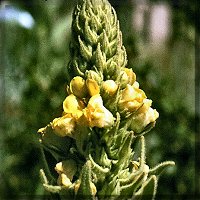
Verbascum thapsus

Verbascum thapsus
Other Names Wooly or common mullein, flannel or velvet plant, Aaron's rod, Adam's flannel, beggar's blanket, beggar's flannel, beggar's stalk, big taper, blanket herb, blanket leaf, bullock's lungwort
Genus: Scrophulariaceae (figwort family)
Edible Parts Mullein is a bi-annual. The first year the plant grows a rosette of leaves that are 6 to 8 inches long and covered with long fuzzy hairs which make them feel thick to the touch. The second year of growth it sends up a stalk that is 4 to 5 feet tall. The leaves grow alternately up the stalk and get smaller as they near the top. A spike of flowers grows on the top. The sulfur-yellow flowers, nearly an inch across are formed of four to five petals that unite at the base to form a short tube.
Geography - It is found growing wild in North America, Europe, and Asia, and has as many as twenty-seven common names. Common Mullein was believed to be first introduced into the United States in the mid-1700's. Mullein can adapt to various environments and can therefore be found in natural meadows, forest openings, neglected pastures, road
Parts used - All parts of Mullein can be used and should be chopped in July when coming into blossom.. The flowers and the leaves of Mullein possess mildly demulcent, expectorant and astringent properties. The whole plant contains slightly sedative and narcotic properties. They can be used in tea or extract form.
Medical use - Mulleins and comfrey are among the oldest known medicinal plants. Flowers and leaves from the common mullein are used for their strong mucilaginous (sticky and viscous) content against all forms of throat and lung irritation. Mullein is traditionally used in herbal medicine to create pain killing and sleep inducing herbal remedies. To avoid further irritation caused by the hairs, it is strongly recommended to finely filter the beverage before taking it. Leaves can also be used topically on dry skin. An oil made from mullien flowers is used for earache, frostbite and bruises.Mullein had been used during the middle age as a remedy for skin and lung diseases in cattle and humans. By the end of the nineteenth century, mullein was given in Europe, the United Kingdom, and the United States to tuberculosis patients; its actions on the lungs are demulcent and emollient. Nineteenth century Eclectic physicians used mullein for inflammatory diseases of the respiratory and genitourinary tracts and the ear canal. Some naturopathic physicians and medical herbalist prescribe Mullein today as a treatment for chronic otitis media and eczema of the ear.
Other uses - The yellow flowers were once used as a blond hair dye, and the stems and leaves were combined to create candlewicks
Pharmacology - The seeds contain rotenone, a saponin that impedes cellular respiration.
Contra-indications - Mullein is generally safe except for rare reports of skin irritation. There are no known reasons to avoid its use during pregnancy or breast-feeding. At the time of writing, there were no well-known drug interactions with mullein.